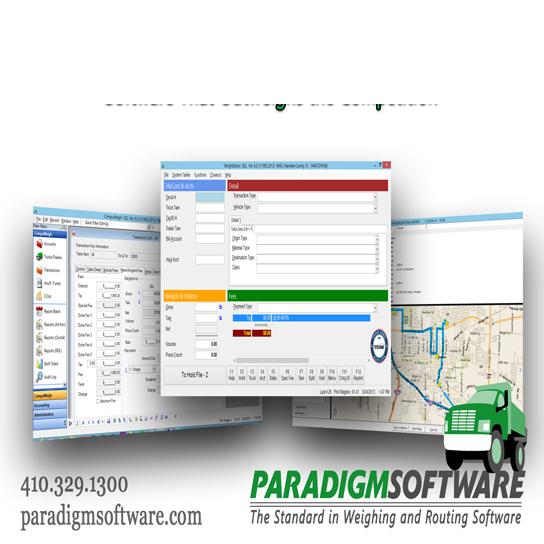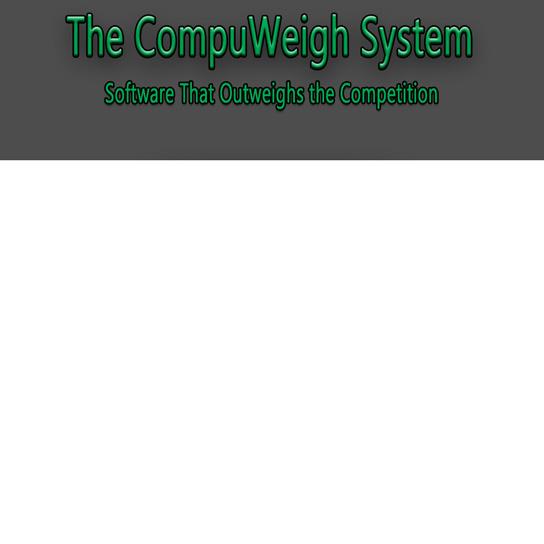
10 minute read
RECYCLING CARTONS IN CANADA IS POSITIVELY SIGNIFICANT
Carton-only bales in Lévis, Quebec, where Sustana Fibers is the first Canadian recycler to process recovered cartons in more than 20 years.
THE FIRST CANADIAN MILL IN TWO DECADES TO PROCESS RECYCLED CARTONS COULD VERY WELL SPARK A TREND, ACCORDING TO CARTON COUNCIL OF CANADA’S ISABELLE FAUCHER
BY KEITH BARKER, EDITOR
This past spring, the Sustana Fibers paper mill in Lévis, Quebec, became the first in two decades to accept sorted recovered cartons in Canada. Formerly, with 33,000 tonnes of cartons collected, all sorted bales sold for recycling in Canada were sent to three recyclers in the U.S. or other international buyers.
Sustana says the decision to begin accepting recovered cartons at their Lévis facility reflects their strategic commitment to innovation and sustainability, as well as an overall increased demand for paper products, such as toilet paper and paper towels. This demand has increased since the onset of Covid-19 in March 2020, and at the same time SOP (Sorted Office Paper) volumes have diminished significantly as businesses have slowed down considerably. Recovered cartons are a good alternative to SOP.
“By recycling alternative fibres, we are proud to enhance our support for a thriving circular economy and help conserve precious resources,” commented Michele Bartolini. “We are also keen to do our part, supporting the supply chain working to make the products people need. By sourcing the cartons locally we reduce CO 2 emissions and create new jobs locally.”
According to Isabelle Faucher, managing director of the Carton Council of Canada, who has worked with Sustana Lévis in making the transition to carton recycling, “Local end-markets go handin-hand with the concept of a lowcarbon, circular economy. While there are buyers for used cartons in other jurisdictions, having a recycling option closer to home further strengthens the sustainability of the carton recycling supply chain.”
She says Sustana’s recycling of cartons in Quebec is significant environmentally, providing an added “pull” for domestic materials recovery and waste diversion, and economically supporting local jobs and contributing to the
production of high-demand domestic paper products. It’s also significant on a symbolic level. “It’s carton recycling on Canadian soil,” she says. “With cartons now being recycled in eastern Canada, there’s a good chance it could inspire recyclers in other parts of the country.”
Currently, Sustana is buying and processing positively sorted carton-only bales supplied by MRFs in eastern Canada. They are running tests and are in the process of establishing how much they can process and what their capacity for this grade will be on a yearly basis. “They already know they can probably take all of the positively sorted cartons generated in Quebec, and some of the volumes generated out of Ontario,” says Faucher.
One question is: to what extent will offices and businesses in Canada resume pre-pandemic activities?
“If we see gradual return for offices and businesses to more or less what it was before the pandemic, then it won’t be such a driver for additional mills to come online as carton recyclers, given cartons are an alternative feedstock for SOP,” says Faucher. “But many observers are saying that we’ve now proved that there is an alternative way to work. People can work from home in instances where they weren’t being given that option before. So there may be a high chance that office activities do not resume to where they were before, hence cartons are likely to remain an attractive feedstock alternative to mills.”
Ultimately, she says, the decision on what grades to work with is one the individual mills make.
In the U.S., there are two mills that have been taking cartons in recent years. Sustana Fibers’ Wisconsin mill, and Great Lakes Tissue in Michigan, both of which Faucher says made the business decision to use recovered cartons based on the demand for finished products and the value of the grade. “It makes sense for them, based on the cost, to process it and the return.” “The second consideration for a mill is whether it is equipped to process cartons. Cartons are different from other fibre grades in that they consist of 20 to 30 percent non-fibre materials. Things like agitation time, pH levels, and water temperature all have to be adapted. It requires some testing and some commitment on the mill’s part to say, ‘Okay, we’re going to try this and work with it.’ It requires an investment in time and, in some cases, equipment.”
“From our experience, we do know that it’s very possible to adapt the equipment that a mill already has in order to pulp cartons. They don’t necessarily need to buy a new pulper.”
On the MRF side of the equation, as the suppliers of carton bales, Faucher

says they are hoping the presence of a Canadian recycler will act as an incentive to encourage those MRFs that are not currently sorting cartons to begin doing so.
“We offer resources to MRFs who want to go in this direction. We can work with a facility to understand their process and suggest changes. Sometimes only very small changes are required to make positive sorting of cartons possible.” RPN


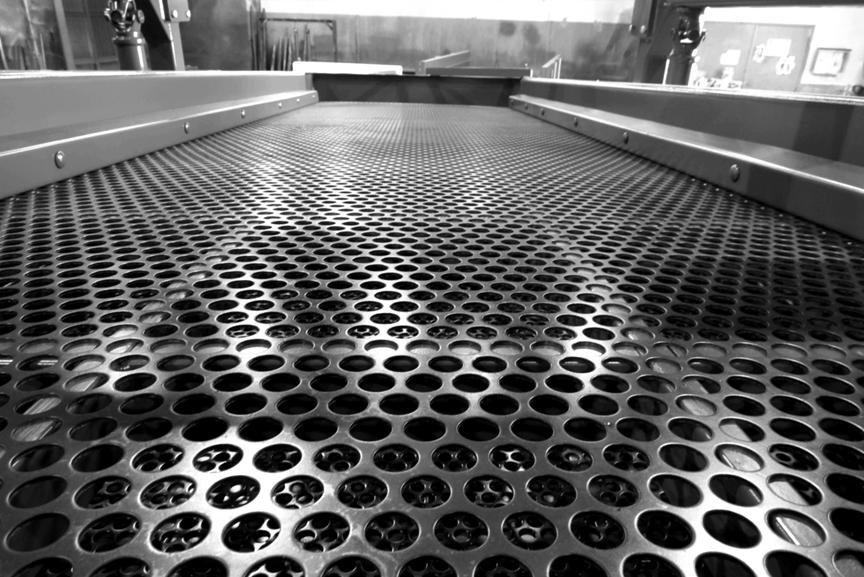

SCREENING Recycled Material, Rubber, Glass, Wood and Metal
Superior Gyratory Screening Technology
Higher speeds, larger strokes and greater capacity
A 100% Written Performance Guarantee
Based on material, volume and e ciency
3-Year Drive Warranty
The best warranty in the Industry
800-663-0323 Phone: 604-539-1029
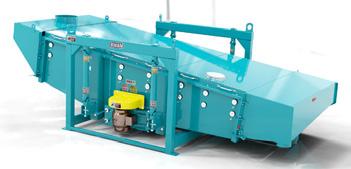
www.bmandm.com Email: sales@bmandm.com
TIRE RECYCLING
ECO GREEN DEBUTS COLOURIZER AND OTR TIRE RECYCLING MACHINE
ECO Green Equipment has introduced a new Rubber Colorizer Equipment line as well as the Eco Razor 63, a compact machine designed to facilitate the efficient cutting, separation and recovery of mining and other very large off-the-road (OTR) tires.
According to Eco Green president Brad Swenson, the new Rubber Colorizer line is designed to handle rubber chunks, shreds and buffings efficiently, colouring up to 10,000 pounds of rubber per hour for use in mulch and surface construction.
“This is by far the most versatile and effective colouring line in the market. In keeping with our company’s goal to help our

users do more with less, we are very proud of this innovation. Its high yield, efficiency and ease of use are like nothing else in the industry.”
“It’s very rewarding to be turning waste into something useful,” said Swenson. “Old tires are now powering paper mills, beautifying parks and forming athletic surfaces for people to play on. The more we can keep out of the landfill, the better.” THE ECO RAZOR 63 FOR OTR TIRES
The patent-pending EcoRazor 63 is equipped with an articulating head that facilitates three-sided rubber removal from OTR tires. Its adjustable knives allow for control of output size, allowing clients to target the most valuable size on the market. Once the high-quality rubber has been retrieved by ECO Green’s specialized mining tire equipment, the remaining tire can be sent for additional processing or be converted into products such as water tanks or wear strips.
Commenting on the new Eco Razor 63 designed to facilitate the efficient recycling of mining and off-the-road tires, Swenson says that while his company is constantly innovating new equipment for efficient rubber recycling, he is especially excited about the unique capabilities of the Eco Razor 63. “This machine is able to break down some of the biggest tires on Earth,” said Swenson. “It has some proprietary features that allow it to remove all of the valuable rubber from these tires with unprecedented efficiency and prepare them for downstream processing.”
COMMODITY FOCUS: RECLAIMED RUBBER Global reclaimed rubber market projected to reach $4.9 billion within a decade
According to a July report compiled by reportlinker. com, the global market for reclaimed rubber will reach US$4.9 billion by 2027. Amid the COVID-19 crisis, the global market for reclaimed rubber estimated at US$2.7 billion in the year 2020, is projected to reach a revised size of US$4.9 billion by 2027, growing at a CAGR of 8.7 percent over the analysis period 2020–2027.
Whole Tire Reclaim (WTR), one of the segments analyzed in the new report, is projected to record a 8.6 percent CAGR and reach US$2.1 Billion by the end of the analysis period. After an early analysis of the business implications of the pandemic and its induced economic crisis, growth in the Butyl segment is readjusted to a revised 9 percent CAGR for the next seven-year period.
According to the report, the reclaimed rubber market

in the U.S. is estimated at US$735.5 million in the year 2020. China, the world’s second-largest econ omy, is forecast to reach a projected market size of US$1 billion by the year 2027 trailing a CAGR of 11.6 percent over the analysis period 2020 to 2027. Among the other noteworthy geographic markets are Japan and Canada, forecast to grow at 5.9 percent and 7.5 percent respectively over the 2020–2027 period. Within Europe, Germany is forecast to grow at approxi mately 6.8 percent CAGR.
LINDNER FIRE PREVENTION SYSTEM USES OPTICAL SENSORS TO COOL HAZARDOUS HOT SPOTS
It’s hard to imagine life without batteries. They’re used in smartphones, cars, toothbrushes and so much more, but only 45 percent of all batteries are disposed of correctly. Lithium batteries, along with other highly flammable materials, such as tar-soaked textile waste, have therefore become one of the most common hazards for serious fires in recycling facilities and those processing and converting waste into solid recovered fuels (SRF). This is largely due to the increasing number of lithium batteries in the general waste stream. When a lithium battery is damaged, a chemical reaction is often initiated, which leads to incredibly high temperatures. This may cause severe damage to facilities and plants and, in the worst case, start a major fire. To minimize such fire hazards, Lindner’s FPS (Fire Prevention System) detects overheated particles in the material stream, cools them to a safe temperature and makes sure that objects that cannot be cooled can be safely removed by hand.
The continuous monitoring of surface temperature at several relevant points has proven to be highly successful in combating potential fire hazards and actively improving safety in facilities, including those that produce solid recovered fuels. Lindner’s FPS uses optical sensors that constantly monitor the temperature on the conveyor belts and automatically trigger a water sprinkling system to cool overheated particles in the material stream.
Each unit also has its own control sensor for detecting objects that cannot be cooled, such as lithium-ion batteries, where the thermal runaway has already been initiated. This triggers an alarm, stopping the conveyor belt under an active cooling nozzle so the hazard can be manually removed. Depending on the application, the threshold value can be chosen freely. To counteract even a delayed reaction of the energy cells, it’s possible to install as many sensor pairs as needed depending on the size of the facility.

To minimize fire hazards, Lindner’s Fire Prevention System detects overheated particles in the waste material stream, cooling them to a safe temperature.
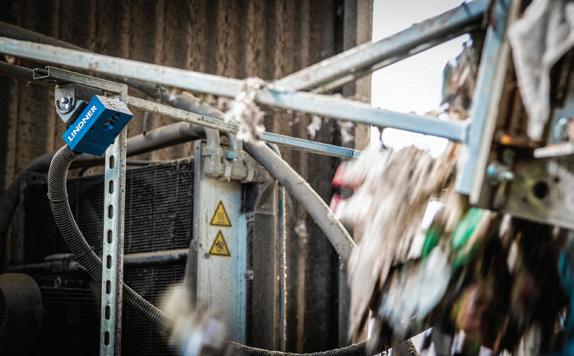
Car-Go-Net ® “The preferred disposable”

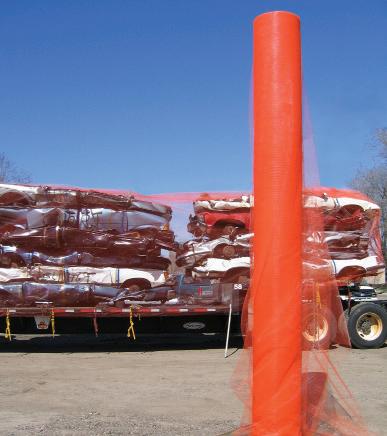
•Fused joints won’t unravel • Easy to apply in a single pass • In stock for immediate shipment

1-800-328-8456 www.industrialnetting.com
ADVERTISER INDEX
American Baler...............................................................33
Bateman Manufacturing.................................................14
BM&M Screening Solutions ...........................................41
Brown Bear Corporation ................................................17
Buffalo Turbine ...............................................................44
Calhoun Super Structure Ltd. ........................................35
ELV Select ......................................................................31
Gensco Equipment.........................................................24
Industrial Netting ............................................................43
Kensal Carbide...............................................................47
Kernic Systems ..............................................................38
LeFort America...............................................................37 LBX Co. ............................................................................2
Machinex..........................................................................3
Mack Trucks .....................................................................4
OverBuilt Inc...................................................................27
Paradigm Software.........................................................45
PMR Inc..........................................................................21
R.M. Johnson Co. ..........................................................23
Scott Equipment.............................................................13
Sennebogen LLC..............................................................9
Shred-Tech .....................................................................48
Van Dyk Recycling Solutions............................................7
Vermeer Canada Inc.......................................................15
CONNECT WITH US
@recyclingproductnews @recyclingproductnews @recyclingpn
RECYCLING
PRODUCT NEWS
LET’S CONNECT FOLLOW US ON TWITTER
@recyclingpn
